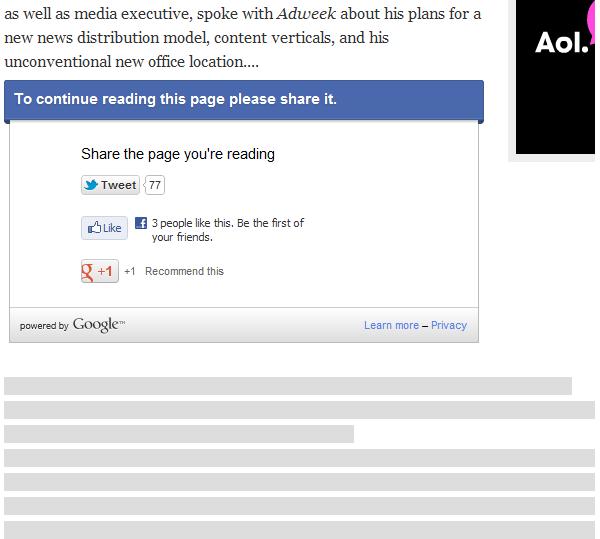

Scott Kidder, director of editorial operations at Gawker Media, tweeted his indignation this morning when he found himself forced to share an Adweek article via Facebook, Twitter, or Google+ if he wanted to read beyond the opening few paragraphs. (The rest of the story was blocked by grey boxes, as you see above.)
He posted a screen shot of the offending prompt and the Tumblr community had its say: “god, this reeks of desperation,” opined jenawithonen. “if you can’t get people to read your articles, write better articles.” The outrage! Combined with the recent blowback against frictionless sharing and Facebook social readers — which put a somewhat similar must-share wall between the reader and the content — it seemed like a new way that media companies were trying to forcibly convert their audiences into promotional devices.
Actually, it was probably an error.
Adweek employs Google’s Consumer Surveys program (an experiment we first reported on last November), a sort of paywall substitute. Adweek embeds Google’s mini surveys in articles; Google pays Adweek for each completed survey. Adweek opts to provide survey alternatives, such as sharing the article on social media. (Max irony: You can see the “survey wall” in action by reading Adweek’s own article about it.)
In this case, the survey question didn’t fire — leaving only the alternative, sharing the article. (We looked at several dozen Adweek articles and couldn’t replicate the must-share interface. Each time, sharing was one option for access, along with a survey.)
A Google spokesperson provided this statement:
Generally, Google Consumer Surveys are designed to show a market research question along with an alternate, publisher defined action, such as signing in or sharing a piece of content. Along with the surveys, we also offer a number of controls to prevent abuse of the system. Unfortunately, in rare cases, as a result of these controls, a prompt runs without a survey question included. This is not the intended behavior and we are currently working on a fix.
So Kidder’s negative experience seems to have been the result of a bug, not a feature, with Adweek playing the role of unwitting host. (I reached out to Adweek for comment but haven’t heard back yet.)
Even if it turned out to be an error, the reaction from readers is instructive (see the responses on Kidder’s Tumblr post). There are creative ways to monetize online content, but tipping the scales into user-hostile territory risks a damaging backlash.
Update: Google now says it has pushed code to fix the problem.